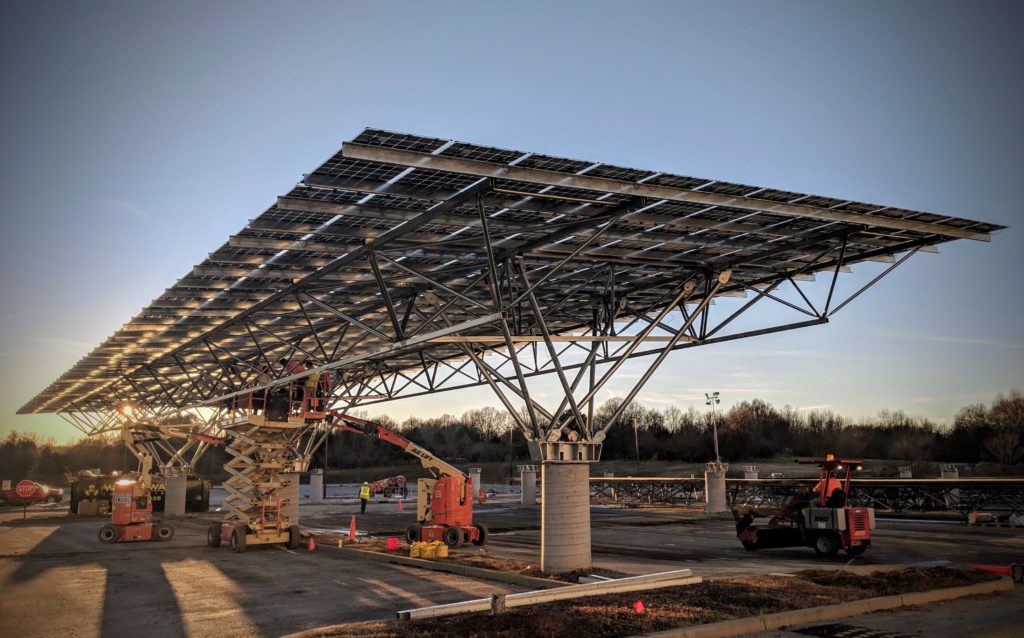Our design is quite distinct compared to a traditional solar canopy — our system’s 3D space frame incorporates a triangulated truss structure, which many customers admire for its modern, pleasingly complex aesthetic. From the beginning, we designed and engineered our solar carports with aesthetics in mind. Not only are our carports functionally straight-forward in their assembly and construction method, they are architecturally different as well.
Michael Levitt, our director of business development, contributed an article to Solar Power World about how aesthetics are becoming increasingly more important for the customers of commercial solar installations as solar becomes more affordable.
You can read the entire article here:
In my role as director of business development at Quest Renewables, I continually seek to better understand our customers’ interests. Quest Renewables is a commercial carport manufacturer, and historically our clientele has been primarily economic buyers. However, as the cost of solar has become significantly more affordable over the last decade, the initial capital investment has become less constraining.
Consumers are now considering a range of criteria to choose the solar system they want, rather than just focusing on bottom-line economics. Subsequently, an increasing number of customers reach out because they are interested in how our product looks. While cost competitiveness continues to be a priority, since solar canopies are part of a customer-built environment, aesthetics are now more important in product selection.
The development of the electric vehicle may provide insight into what the future of solar may hold. In the early/mid-2000s there were several newly developed electric cars on the market which, like solar, offered an alternative to fossil fuel-based products. However, electric vehicles did not gain a strong foothold with consumers until 2012 with the release of the Tesla Model S. The Model S was the first widely available electric vehicle that was aesthetically desirable. Following the Model S, demand for electric vehicles skyrocketed and Tesla has since become the most valuable automotive company in the United States, with other companies clamoring to develop new products to keep up.
How aesthetics is changing the solar industry
Commercial and industrial markets have shown a rising demand for aesthetics-driven installations. In February 2020, Sage Energy, a renewable energy consulting firm, released a request for proposals for a nearly 1-MW solar carport at a new manufacturing facility in Texas. Sage’s client, a multinational tech company, outlined a peculiar timeline. The deadline for the structural installation was set for April 22 — Earth Day — allocating only two months to engineer, fabricate and erect the structural component of the project.
Meanwhile, the electrical scope and interconnection were given a more generous deadline later in the summer. While the solar array will surely provide a favorable economic return, in the long run, it seems that the real investment was in the positive press of an Earth Day ribbon-cutting ceremony for its sustainable factory.
This strategy reflects the growing demand for statement solar installations in the corporate sector. Earlier this year, Larry Fink, founder and CEO of BlackRock, the world’s largest asset manager, released a letter addressed to the world’s most prominent executives. The letter stated that the firm would begin to withdraw investments that present “high sustainability-related risk,” urging companies to adopt sustainability as a top priority.
Following the letter’s release, a wave of corporations announced highly ambitious sustainability initiatives. Delta committed $1 billion towards reaching net-zero emissions over 10 years, while Microsoft pledged to offset its entire historical carbon footprint by 2050.
How to use aesthetics to stay competitive
Solar developers and EPCs should seek to integrate new products that push design and visual appeal as a competitive feature. For panel options, there are a variety of “designer” modules for customers to consider. Solaria, a California-based panel manufacturer, puts aesthetics front and center in its marketing, its slogan reading, “Beauty, Efficiency, and Power.”
Solaria’s panels, which are free of bus bars and any visible circuitry, are designed to look chic and contemporary. Other companies, like Trina Solar, have invested heavily in developing bifacial glass modules, which offer a boost in production and present as sleek and modern. By incorporating well-designed panel selections, developers can directly appeal to customers who are interested in looks and panel efficiency.
For Quest Renewables, some of our most rewarding projects occur when we successfully leverage aesthetics. Our design is quite distinct compared to a typical solar canopy — our system’s 3D space frame incorporates a triangulated truss structure, which many customers admire for its modern, pleasingly complex aesthetic.
While high-quality images and videos are essential for any company with a digital presence, we also use a variety of tools to maximize our visual impact. Drone technology lets us capture aerial views of our installations, even those on large multi-story parking lots. We have also invested in an interactive 3D rendering gallery to create an immersive experience for our customers. By taking advantage of technology in our marketing efforts, we work to affirm our reputation as an innovator and forward-thinking company.
As in any industry, increased demand leads to increased competition, and it is clear the solar industry is primed for a surge in development over the coming decades. To stay competitive, companies will need to find innovative ways to adapt to growth in the market. Successful companies are going to have to find ways to differentiate themselves from the pack and incorporating aesthetics can be a powerful way to stand out.
If you would like to learn more, please contact us at sales@questrenewables.com or 404-536-5787.
